Karolina Hird, Grace Mappes, Kateryna Stepanenko, Angelica Evans, and Mason Clark
Russia advanced legal mechanisms to reform the Leningrad Military District as part of ongoing large-scale military reforms. The Russian federal portal of draft regulatory legal acts published a presidential decree on October 8, prepared by the Russian Ministry of Defense (MoD), which proposes stripping the Northern Fleet (NF) of its status as an “interspecific strategic territorial association.”[1] Russian state media noted that the proposal indicates that the NF will no longer be a separate military-administrative unit equal to a military district, suggesting that the NF and its four constituent regions (The Komi Republic, Arkhangelsk, and Murmansk oblasts, and the Nenets Autonomous Okrug) will be transferred to the reformed Leningrad Military District.[2] Russian military analyst Yuri Fedorov noted that the recreation of the Leningrad Military District suggests that Russia is preparing for possible conflicts with Baltic states and NATO.[3] The Russian military merged the Moscow and Leningrad Military Districts into the Western Military District in 2010.[4] The MoD created the Northern Fleet in 2014 out of territory covered by the Western Military District, and Russian President Vladimir Putin made the NF a military-administrative unit equal to a military district starting January 1, 2021.[5] Russian Defense Minister Sergei Shoigu proposed the recreation of the Moscow and Leningrad Military Districts on the basis of the Western Military District (reversing the 2010 and 2014 changes) in December of 2022, and confirmed that these military districts were under active formation as of August 2023.[6] The MoD’s decision to re-divide the WMD indicates Russia sees the need to restructure its forces facing NATO and likely posture on the Finnish border, although it remains unclear how Russia will be able to mobilize, train, and organize these forces into new military district-level formations.
Ukrainian forces continued counteroffensive operations near Bakhmut and marginally advanced in western Zaporizhia Oblast on October 8. Geolocated footage published on October 8 shows that Ukrainian forces made limited gains north of Novoprokopivka (14km south of Orikhiv), and a Russian milblogger claimed that Ukrainian forces also advanced near Kopani (10km southwest of Orikhiv).[7] The Ukrainian General Staff reported that Ukrainian forces achieved partial success northeast of Andriivka (7km southwest of Bakhmut), and Russian sources claimed that Ukrainian forces continued attacks near Andriivka, and Kurdyumivka (11km southwest of Bakhmut).[8] Russian and Ukrainian sources reported that deteriorating weather conditions are impacting both Russian and Ukrainian operations across the theater. Ukrainian Tavriisk Group of Forces Spokesperson Colonel Oleksandr Shtupun stated that Russian drone and aviation activity has decreased in the past few days due to poor weather.[9] Russian milbloggers claimed that deteriorating weather conditions in the Bakhmut and Zaporizhia directions are impacting Ukrainian offensive operations as well as Russian aerial reconnaissance operations.[10] Ukrainian Eastern Group of Forces Spokesperson Captain Ilya Yevlash reiterated that poor weather may impact drone and aviation operations but that the weather will not halt Ukraine’s counteroffensive.[11]
Russian forces are intensifying mining efforts in the Robotyne-Verbove area and seek to fix Ukrainian forces on areas of the front away from western Zaporizhia Oblast. Russian milbloggers claimed that Russian forces have begun remining previously cleared areas on the Robotyne-Verbove line (10km south to 18km southeast of Orikhiv) to achieve tactical surprise.[12] The milbloggers claimed that heavy Russian mining and remining efforts have disrupted the movement of heavy Ukrainian cargo and equipment in these areas in recent days. A prominent Kremlin-affiliated milblogger claimed that Russian forces intensified tactical offensive operations in several areas of the front beyond Zaporizhia Oblast in order to stretch Ukrainian defenses and divide Ukrainian attention.[13] Ukrainian Tavriisk Group of Forces Spokesperson Colonel Oleksandr Shtupun stated that Russian forces are trying to fix Ukrainian forces in the Avdiivka and Marinka directions and prevent them from deploying reserves to the Zaporizhia direction.[14]
Russian sources are highlighting apparent fault lines between regular Russian forces and irregular formations of the Donetsk People’s Republic (DNR). A Russian milblogger claiming to be a Buryat soldier fighting in the 37th Motorized Rifle Brigade [MRB] (36th Combined Arms Army, Eastern Military District) responded on October 7 to a post published by another milblogger on August 13 that accused the 37th MRB of abandoning their positions around Novodonetske (in the Donetsk-Zaporizhia border area) during Ukrainian attacks that ultimately liberated the village, leaving only elements of the DNR “Kaskad” operational tactical combat formation to defend the area.[15] The Buryat milblogger refuted this story and claimed that “Kaskad” conducts a small part of combat activities on the front while regular Russian troops shoulder more of the offensive burden, and derided other DNR units for having positions far behind frontline areas held by regular units.[16] The milblogger also claimed that DNR units have low skill levels and that regular Russian troops distrust them.[17] The allegations made by this milblogger against DNR formations suggest that there is continued friction between DNR forces and regular Russian forces, which is likely to further complicate efforts to integrate DNR forces into the regular Russian military as part of ongoing military reforms.[18]
Ukrainian Air Force Spokesperson Colonel Yuriy Ihnat expressed concern over an anticipated Russian Shahed 131/136 drone strike campaign against Ukraine this winter. Ihnat stated on October 8 that Russian forces have increased the intensity of Shahed strikes recently, as Ukrainian officials previously warned.[19] Ihnat stated that Russian forces used 1,000 Shahed drones during the 2023-23 heating season but used a record 500 drones during September 2023 alone, indicating that Ukraine needs to prepare seriously for Russia’s 2023-24 winter drone strike campaign. Ihnat noted that Ukraine is gradually replacing Soviet air defense systems with Western-provided systems and intends to use these systems to protect Ukrainian energy facilities, port infrastructure, grain silos, and other critical infrastructure against Russian drone strikes this winter. Ihnat added that Russian authorities want to increase the production of Shahed drones domestically but cannot overcome their reliance on Iran for certain technologies and spare parts required for production.[20]
The Center for Strategic and International Studies (CSIS) observed satellite imagery showing that rail traffic between North Korea and Russia “dramatically” increased since Russian President Vladimir Putin met with North Korean dictator Kim Jong Un on September 12-17.[21] CSIS’ Beyond Parallel project found that satellite imagery captured on October 5 showed an “unprecedented” 73 freight railcars at the North Korea’s Tumangang Rail Facility. Beyond Parallel noted that previous satellite images showed a maximum of approximately 20 railcars at the Tumangang facility at once over the past five years. Beyond Parallel also observed shipping crates/containers and equipment laid out in the open at the main warehouse area at the Tumangang facility, although the contents of the transported goods remain unclear. Beyond Parallel remarked that the external characteristics of the containers and equipment are different from those observed during the past five years at the facility and assessed that it is “probable that these shipments are, or include, munitions and artillery.” Russian milbloggers and sources amplified Beyond Parallel findings in the Russian information space without confirming or denying the possibility of North Korean arms supplies to Russia.[22] ISW previously assessed that Putin may be open to some forms of technological and defensive cooperation with North Korea in return for North Korean artillery ammunition as long as such cooperation does not trigger secondary sanctions against Russia.[23]
The Russian federal government continues to disenfranchise certain ethnic minority federal subjects (regions) while selectively empowering others. Radio Liberty’s Tatar-Bashkir service Idel Realii amplified an opinion piece written by Tatar activist Ruslan Aisin on October 8 which criticizes the implementation of a new Tatarstan state national policy as federally enforced “feudalism.”[24] Aisin noted that the new policy dropped a provision on “strengthening Tatarstan identity,” which Aisin emphasized is aimed at Russifying ethnically diverse populations living in the Russian Federation, and claimed that the Russian federal government likely prompted the provision’s removal.[25] Aisin remarked that the removal of this provision is meant to deprive ethnic minority regions of their ability to empower their own cultures, languages, and traditions but questioned why Chechen Republic Head Ramzan Kadyrov is allowed to publicly promote Chechen traditions and identity.[26] The Russian Ministry of Defense (MoD) and the Kremlin have recently signaled explicit support for Kadyrov and his style of rule in Chechnya despite increased interethnic tensions within Russian society and the military.[27] The suggestion that Russian federal policy is purposefully trying to disenfranchise Tatar identity while simultaneously empowering Kadyrov indicates that the Kremlin is interested in rewarding the ethnic minority regions that are the most overtly loyal to the Kremlin and provide the Kremlin with substantial military manpower for the war in Ukraine.
Key Takeaways:
- Russia advanced legal mechanisms to form the Leningrad Military District as part of ongoing large-scale military reforms.
- Ukrainian forces continued counteroffensive operations near Bakhmut and marginally advanced in western Zaporizhia Oblast on October 8.
- Russian forces are intensifying mining efforts in the Robotyne-Verbove area and seek to fix Ukrainian forces on areas of the front away from western Zaporizhia Oblast.
- Russian sources are highlighting apparent fault lines between regular Russian forces and irregular formations of the Donetsk People’s Republic (DNR).
- Ukrainian Air Force Spokesperson Colonel Yuriy Ihnat expressed concern over an anticipated Russian Shahed 131/136 drone strike campaign against Ukraine this winter.
- The Center for Strategic and International Studies (CSIS) observed satellite imagery showing that rail traffic between North Korea and Russia “dramatically” increased since Russian President Vladimir Putin met with North Korean dictator Kim Jong Un on September 12-17
- The Russian federal government continues to disenfranchise certain ethnic minority federal subjects (regions) while selectively empowering others.
- Russian forces continued offensive operations along the Kupyansk-Svatove-Kreminna line, near Bakhmut, along the Avdiivka-Donetsk City line, western Donetsk Oblast, and on the Donetsk-Zaporizhia Oblast administrative border on October 8 and reportedly advanced in some areas.
- Prague-based Russian-language outlet Current Time reported on October 8 that the number of desertion cases within the Russian military has increased.
We do not report in detail on Russian war crimes because these activities are well-covered in Western media and do not directly affect the military operations we are assessing and forecasting. We will continue to evaluate and report on the effects of these criminal activities on the Ukrainian military and the Ukrainian population and specifically on combat in Ukrainian urban areas. We utterly condemn these Russian violations of the laws of armed conflict, Geneva Conventions, and humanity even though we do not describe them in these reports.
- Russian Main Effort – Eastern Ukraine (comprised of two subordinate main efforts)
- Russian Subordinate Main Effort #1 – Capture the remainder of Luhansk Oblast and push westward into eastern Kharkiv Oblast and encircle northern Donetsk Oblast
- Russian Subordinate Main Effort #2 – Capture the entirety of Donetsk Oblast
- Russian Supporting Effort – Southern Axis
- Russian Mobilization and Force Generation Efforts
- Activities in Russian-occupied areas
- Russian Information Operations and Narratives
Russian Main Effort – Eastern Ukraine
Russian Subordinate Main Effort #1 – Luhansk Oblast (Russian objective: Capture the remainder of Luhansk Oblast and push westward into eastern Kharkiv Oblast and northern Donetsk Oblast)
Russian forces continued offensive operations in the Kupyansk area on October 8 and reportedly recently advanced. A Russian milblogger claimed that Russian forces advanced near Lyman Pershyi (12km northeast of Kupyansk), the Synkivka rail station (8km northeast of Kupyansk), on the Tymkivka-Ivanivka line (18-20km east of Kupyansk), and on the Orlyanka-Yahidne line (21-22km southeast of Kupyansk)on October 7.[28] ISW has observed no confirmation of this claim, however. Other Russian milbloggers claimed that Russian forces attacked near Petropavlivka (7km east of Kupyansk), Synkivka, and Kyslivka (20km southeast of Kuypyansk) on October 8.[29] The Ukrainian General Staff reported that Ukrainian forces repelled multiple Russian attacks near Synkivka and Ivanivka (20km east of Kupyansk).[30] Ukrainian Eastern Group of Forces Spokesperson Captain Ilya Yevlash stated that Russian forces have increased their use of aviation in the Kupyansk-Lyman direction to support increased offensive operations in these areas and compensate for their lack of artillery.[31]
Russian forces continued offensive operations on the Svatove-Kreminna line on October 8 and recently marginally advanced. Geolocated footage posted on October 7 shows that Russian forces advanced along a roast east of Makiivka, Luhansk Oblast (22km northwest of Kreminna) to positions just under two kilometers from the outskirts of the settlement.[32] Russian milbloggers made competing claims about Russian advances near Makiivka; one milblogger claimed that Russian forces reached the outskirts of the settlement, while another claimed that Russian forces advanced to within 600 meters of the settlement, and a third claimed that Russian forces remain just over one kilometer from the settlement – all inconsistent with ISW’s furthest observed Russian advance in the area, approximately two kilometers from the settlement.[33] Another milblogger claimed that Russian forces made unspecified advances near Makiivka and that Russian forces ultimately aim to push Ukrainian forces to the west bank of the Oskil River, an objective that Russian forces are likely too degraded to achieve in the near term.[34]
Ukrainian forces reportedly conducted unsuccessful offensive operations on the Kupyansk-Svatove-Kreminna line on October 8. The Russian Ministry of Defense (MoD) claimed that Russian forces repelled Ukrainian attacks near Orlyanka in Kharkiv Oblast; Novoselivske (15km north of Svatove), Makiivka, and Dibrova (5km southwest of Kreminna) in Luhansk Oblast; Torske (14km west of Kreminna) in Donetsk Oblast; and in the Serebryanske forest area (11km south of Kreminna).[35] A Russian milblogger claimed that Russian forces repelled a Ukrainian attack near Torske.[36]
Russian Subordinate Main Effort #2 – Donetsk Oblast (Russian objective: Capture the entirety of Donetsk Oblast, the claimed territory of Russia’s proxies in Donbas)
Ukrainian forces continued offensive operations near Bakhmut on October 8 and reportedly advanced. The Ukrainian General Staff and other Ukrainian military sources reported that Ukrainian forces had partial success northeast of Andriivka (7km southwest of Bakhmut).[37] The Russian Ministry of Defense (MoD) claimed that elements of the Russian Southern Grouping of Forces repelled Ukrainian attacks near Andriivka.[38] A Russian milblogger claimed that Ukrainian forces are trying to bypass Kurdyumivka (11km southwest of Bakhmut) from the northeast and attacking in the direction of Zelenopillya (12km southwest of Bakhmut) to do so.[39] The milblogger also noted that Ukrainian forces have recently shifted their efforts towards Kurdyumivka in order to capture the remaining tactical heights south of Bakhmut.[40] Another milblogger reported that there are fewer significant Ukrainian movements in this area due to deteriorating weather conditions and heavy rain, which is inhibiting the use of aerial reconnaissance.[41]
Russian forces conducted limited ground attacks to regain lost positions near Bakhmut on October 8 and reportedly made limited advances. The Ukrainian General Staff reported that Ukrainian forces repelled Russian attacks southwest of Bakhmut near Andriivka and Klishchiivka and northwest of Bakhmut near Bohdanivka (6km northwest).[42] A Russian milblogger claimed that Russian forces are counterattacking on the northern flank of Bakhmut and pushed Ukrainian forces back near Berkhivka (directly northwest of Bakhmut) and attacked towards Dubovo-Vasylivka (5km northwest of Bakhmut) and Yakovlivka (12km northeast of Bakhmut).[43]
Ukrainian forces did not conduct any claimed or confirmed ground attacks on the Donetsk City-Avdiivka line on October 8.
Russian forces continued ground attacks on the Donetsk City-Avdiivka line on October 8 and reportedly advanced. The Ukrainian General Staff and Ukrainian Tavriisk Group of Forces Spokesperson Colonel Oleksandr Shtupun reported that Ukrainian forces repelled 20 Russian attacks near Avdiivka (directly north of Donetsk City), on the northwestern outskirts of Donetsk City near Pervomaiske, and on the southwestern outskirts of Donetsk City near Marinka, Krasnohorivka, and Novomykhailivka.[44] Shtupun also noted that Russian attacks in the Avdiivka and Marinka directions are meant to distract Ukrainian forces and prevent the transfer of Ukrainian reserves to the Zaporizhia direction.[45] A Russian milblogger posted footage reportedly of Russian “Storm-Z” units training somewhere in the Avdiivka direction.[46] Other Russian sources claimed that Russian forces recently managed to occupy new positions in northern Marinka and had partial success near Krasnohorivka (the settlement north of Avdiivka).[47]
Russian Supporting Effort – Southern Axis (Russian objective: Maintain frontline positions and secure rear areas against Ukrainian strikes)
Ukrainian forces continued offensives in western Donetsk Oblast and in the Donetsk-Zaporizhia Oblast border area on October 8 but did not make any confirmed advances. The Russian Ministry of Defense (MoD) claimed that elements of the Russian Eastern Grouping of Forces repelled Ukrainian attacks northeast of Mykilske (4km southwest of Vuhledar and 33km southeast of Velyka Novosilka), west of Novodonetske (11km southeast of Velyka Novosilka), west of Staromayorske (8km southwest of Velyka Novosilka), and north of Pryyutne (15km southwest of Velyka Novosilka).[48] A Russian milblogger claimed that Ukrainian forces unsuccessfully attacked in an unspecified forest belt likely west of Staromayorske, are trying daily to improve positions north of Pryyutne with decreasing intensity, and are attempting to regain lost positions west of Novodonetske.[49] The UK MoD assessed that the Velyka Novosilka sector of the frontline has been relatively quiet for the last four weeks and that Ukrainian forces liberated at least 125 square kilometers on this frontline.[50] ISW assesses that Ukrainian forces liberated nearly 215 square kilometers in the Donetsk-Zaporizhia Oblast border area since the start of the counteroffensive in June 2023. The UK MoD also observed that Ukrainian operations in the Velyka Novosilka area have successfully fixed elements of the 5th and 36th Combined Arms Armies (CAAs) of the Eastern Military District (EMD) and some unspecified airborne elements to the area.[51]
Russian forces counterattacked in western Donetsk Oblast and in the Donetsk-Zaporizhia Oblast border area on October 8 but did not make any confirmed territorial gains. A Russian milblogger claimed that Russian Spetsnaz and motorized rifle units have captured almost a dozen Ukrainian positions and pushed Ukrainian forces from an unspecified “strategically important settlement.”[52] The milblogger added that elements of the Russian 34th Separate Rifle Brigade (49th CAA, Southern Military District [SMD]) are operating in the Donetsk-Zaporizhia Oblast border area. Another milblogger claimed that elements of the 43rd Separate Special Purpose Company (29th CAA, EMD) are operating north of Mykilske.[53] The Ukrainian General Staff reported that Ukrainian forces repelled 10 Russian assaults near Vodyane (6km northeast of Vuhledar and 34km east of Velyka Novosilka) and Zolota Nyva (10km southeast of Velyka Novosilka).[54]
Ukrainian forces continued offensive operations in western Zaporizhia Oblast on October 8 and made limited territorial gains north of Novoprokopivka (14km south of Orikhiv). Geolocated footage published on October 8 indicated that Ukrainian forces made limited advances along the T-0408 highway on Novoprokopivka’s northern outskirts.[55] A Kremlin-affiliated milblogger claimed that Ukrainian forces continue to attack towards Kopani (10km southwest of Orkhiv) and made some advances.[56] The milblogger added that the Russian fortified defensive line is located northeast and southeast of Kopani and that Ukrainian forces also unsuccessfully attacked Russian positions on the outskirts of Novoprokopivka and on the approaches to Verbove (16km southeast of Orikhiv).[57] The milblogger observed that Russian forces have been unsuccessful in cutting off flanks of Ukrainian forces advancing towards Novoprokopivka and Verbove throughout the week but that Ukrainian forces did not make significant advances.[58] Another Russian milblogger claimed that intense battles are ongoing on the Robotyne (11km south of Orikhiv)-Verbove line and that Russian artillery fire repelled two Ukrainian sabotage and reconnaissance groups northwest of Verbove.[59]
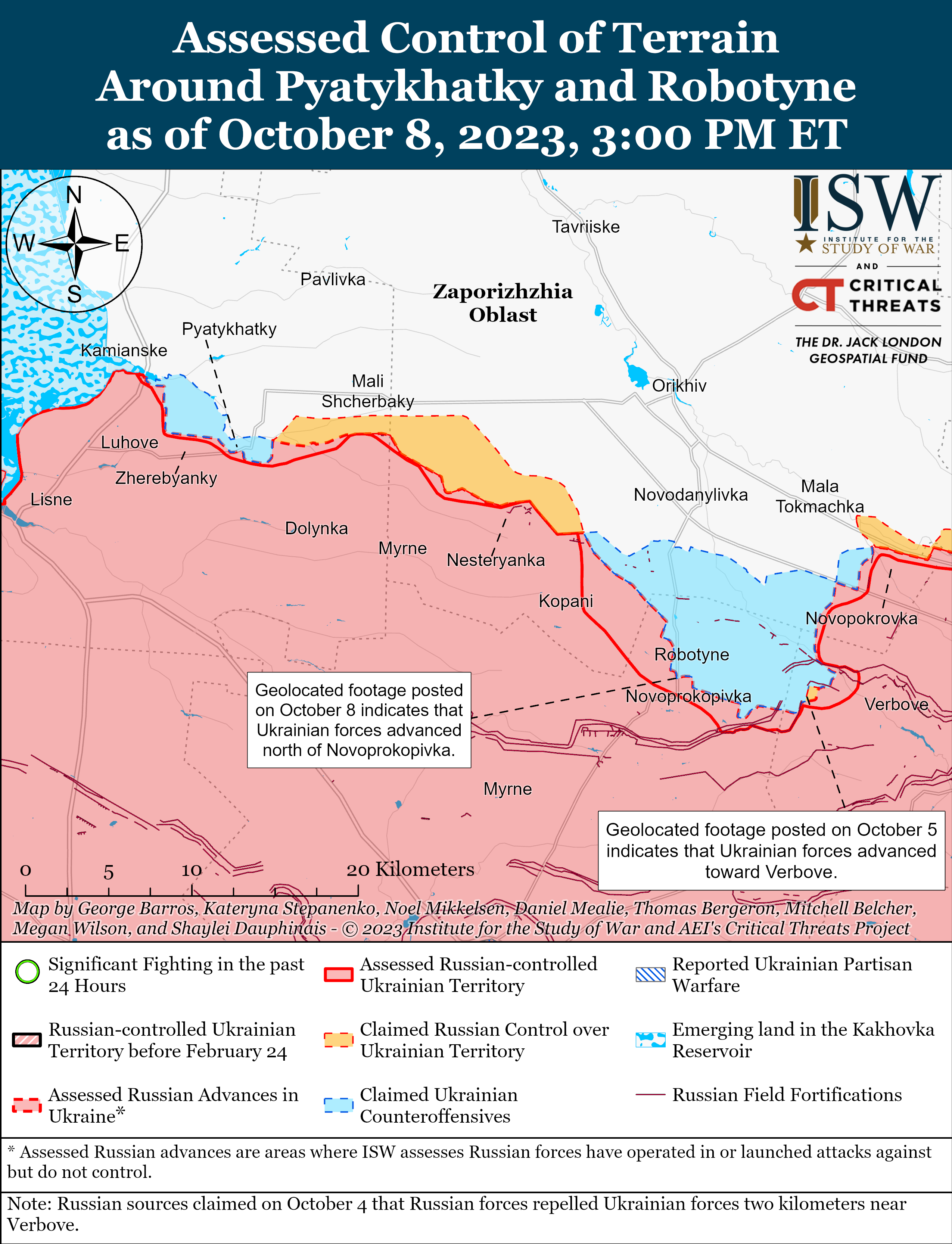
Ukrainian Tavriisk Group of Forces Spokesperson Colonel Oleksandr Shtupun stated that Russian forces continue to strengthen their defenses around Tokmak and that the city has become a fortress surrounded by circular defensive lines.[60]
Russian sources continued to discuss Ukrainian operations across the Dnipro River and near the Antonivsky Bridge in Kherson Oblast. A Kremlin-affiliated milblogger claimed that Ukrainian forces continued to consolidate positions on the Dnipro River delta islands on the east (left) bank of the river and are achieving partial success.[61] The milblogger specified that Ukrainian forces do not have a serious bridgehead in the area, however. Another milblogger claimed that Ukrainian forces still hold positions under Antonivsky Bridge and that Ukrainian sabotage and reconnaissance units occasionally venture to Oleshky (7km east of Kherson City) using the bridge as a cover.[62]
Russian sources, including the Russian MoD, claimed that Ukrainian forces unsuccessfully attempted to strike the Dzhankoi rail station with a modified S-200 missile on the evening of October 7.[63]
Russian Mobilization and Force Generation Efforts (Russian objective: Expand combat power without conducting general mobilization)
Prague-based Russian-language outlet Current Time reported on October 8 that the number of desertion cases within the Russian military has increased.[64] Current Time reported that “Go Through the Forest,” a Russian organization that helps Russian citizens avoid mobilization, has observed an increasing number of Russian servicemen deserting since May 2023. The increase in desertion cases is reportedly due to the Russian military beginning to allow contract servicemen to take vacations in late April and May, which many servicemen never returned from. Current Time stated that the Russian military refuses to give vacations to mobilized personnel.
The Kherson Oblast occupation military registration and enlistment office announced continued efforts to discourage draft evasion in occupied Kherson Oblast on October 7.[65] The office announced several new and increased fines related to military registration, including fines against: employers who fail to notify employees subject to conscription and send them to assembly points; employers who fail to provide the office with lists of employees liable for military service; employers who fail to update the office on the dismissal of an employee liable for military service; locals who fail to fulfill their military transport duties; and locals who violate the requirement to register for military service.
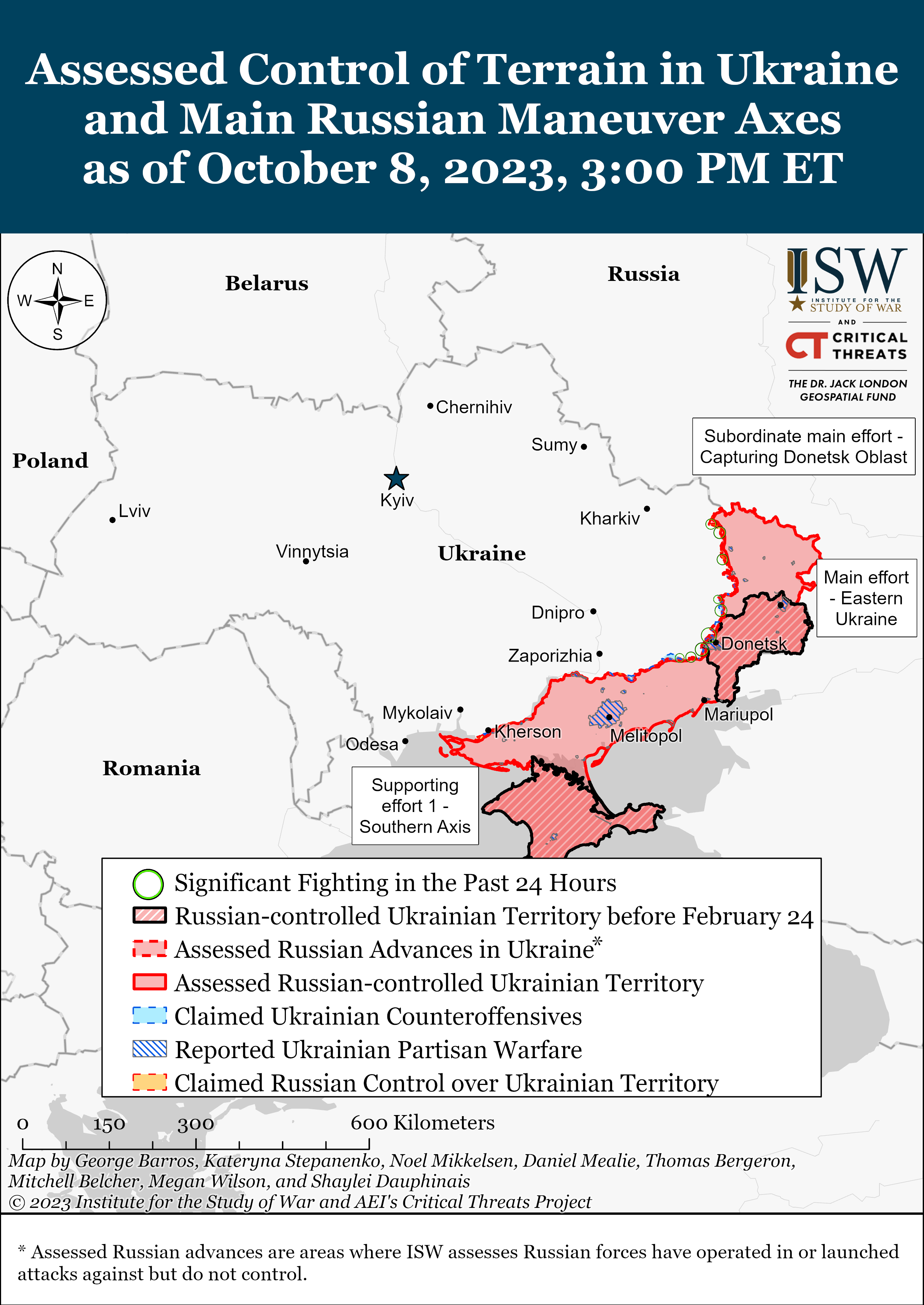
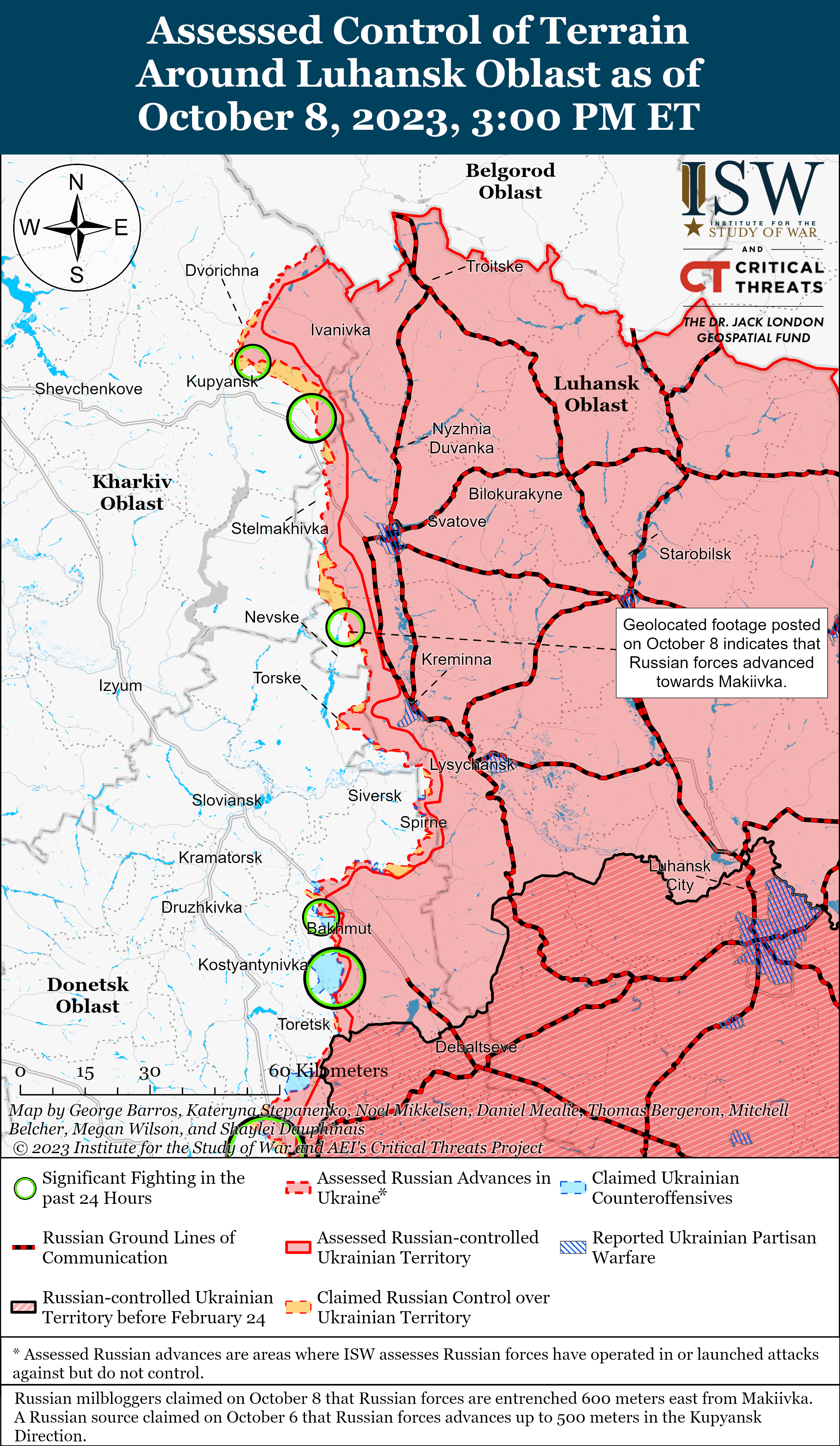
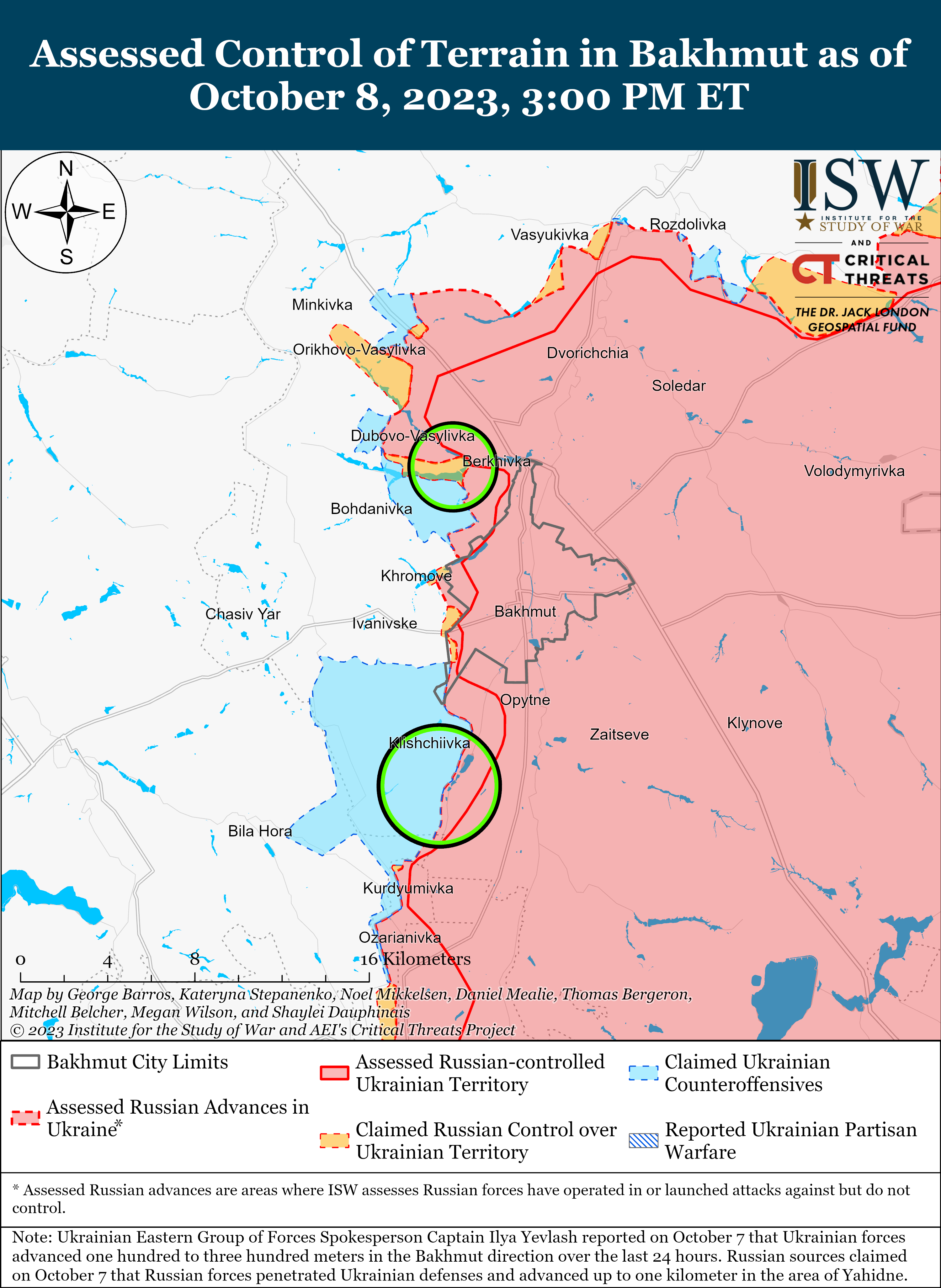
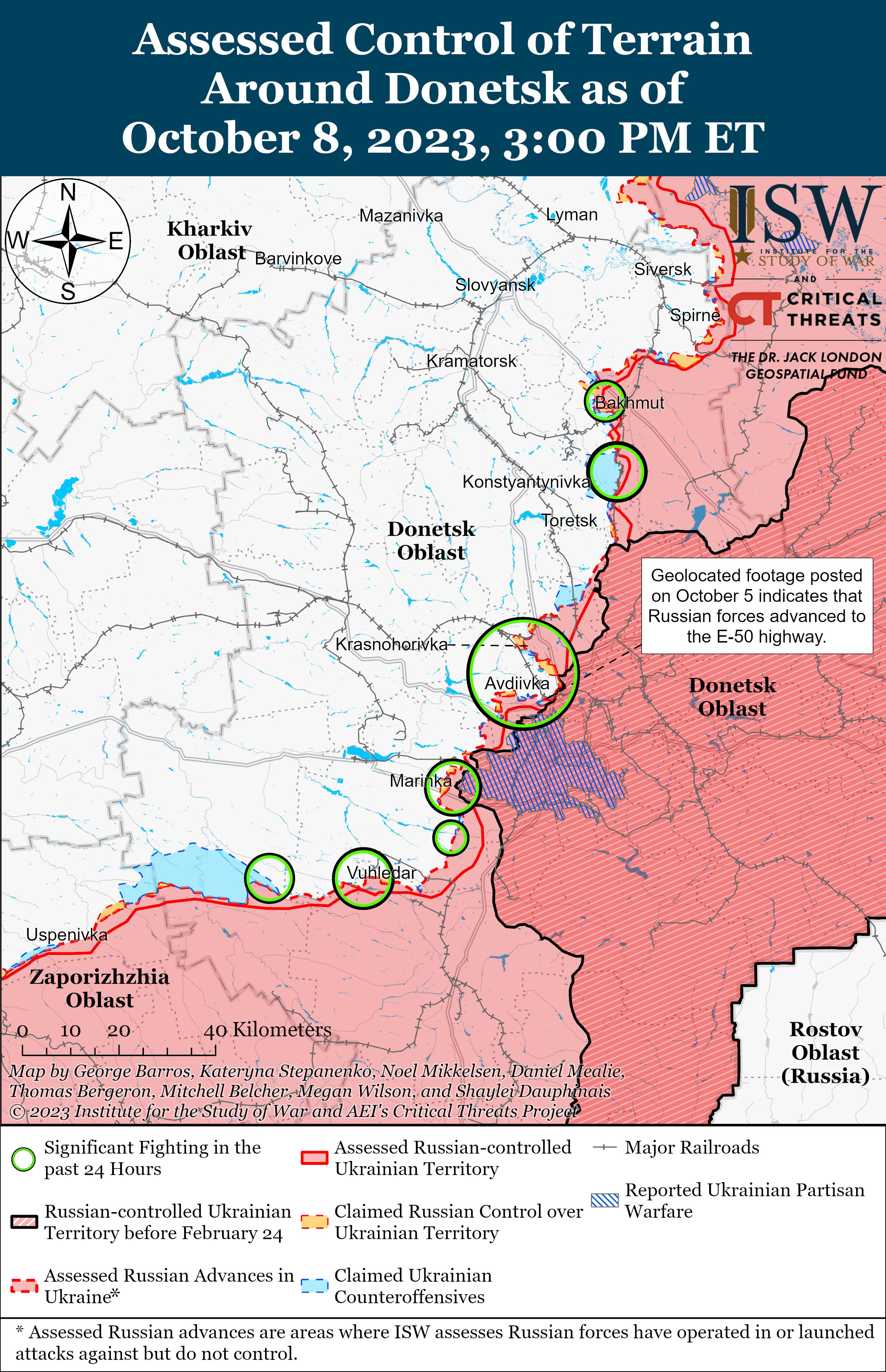
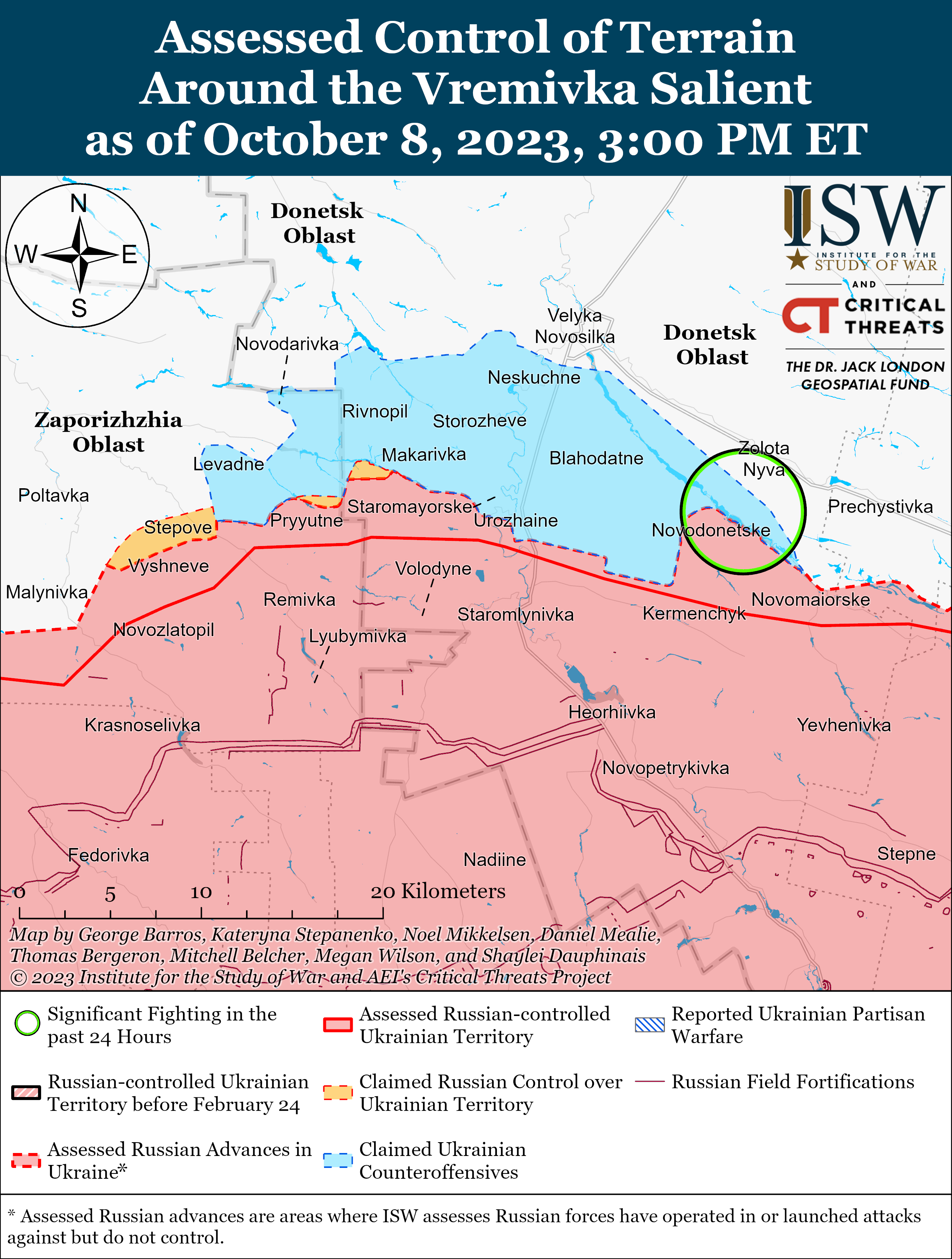
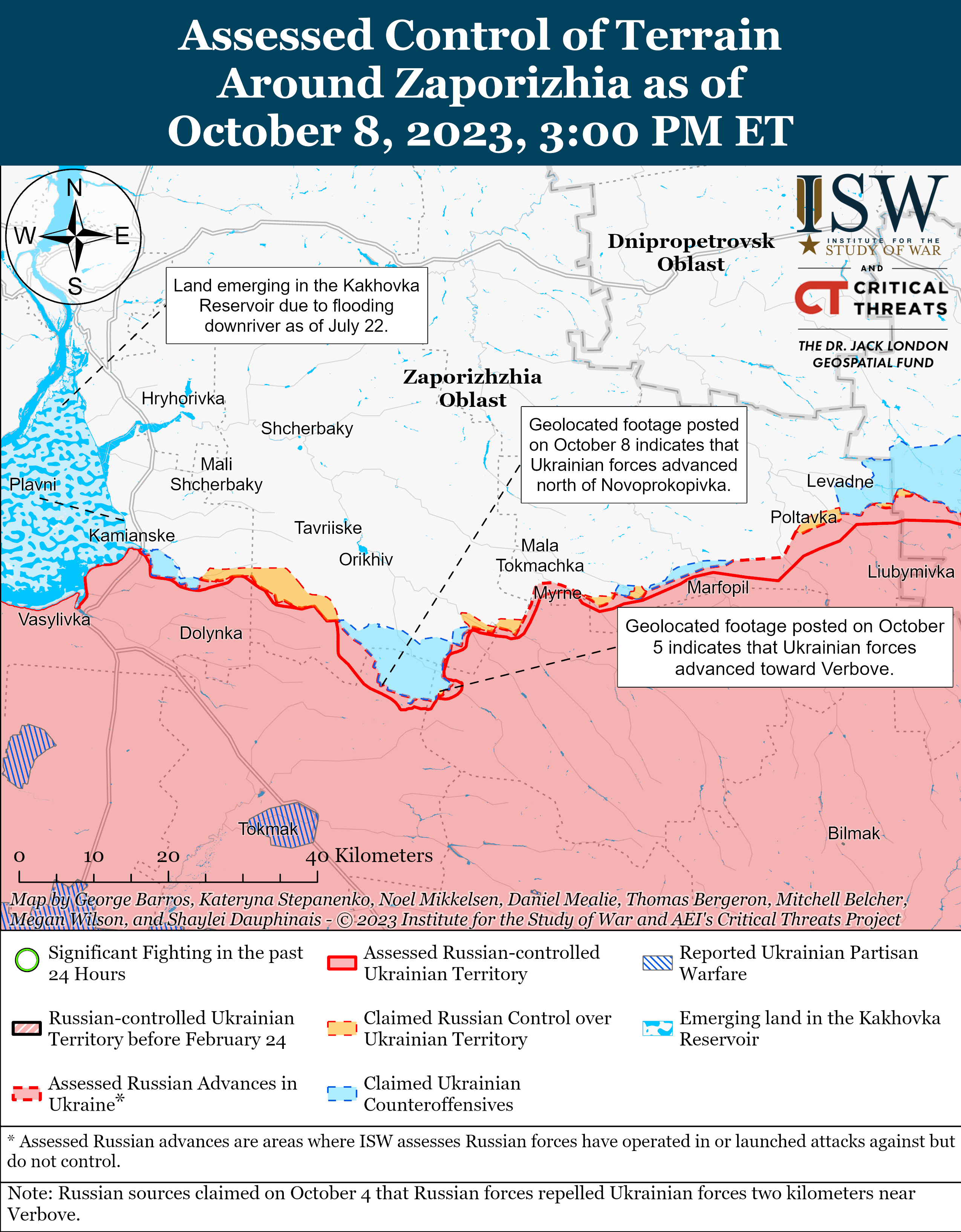
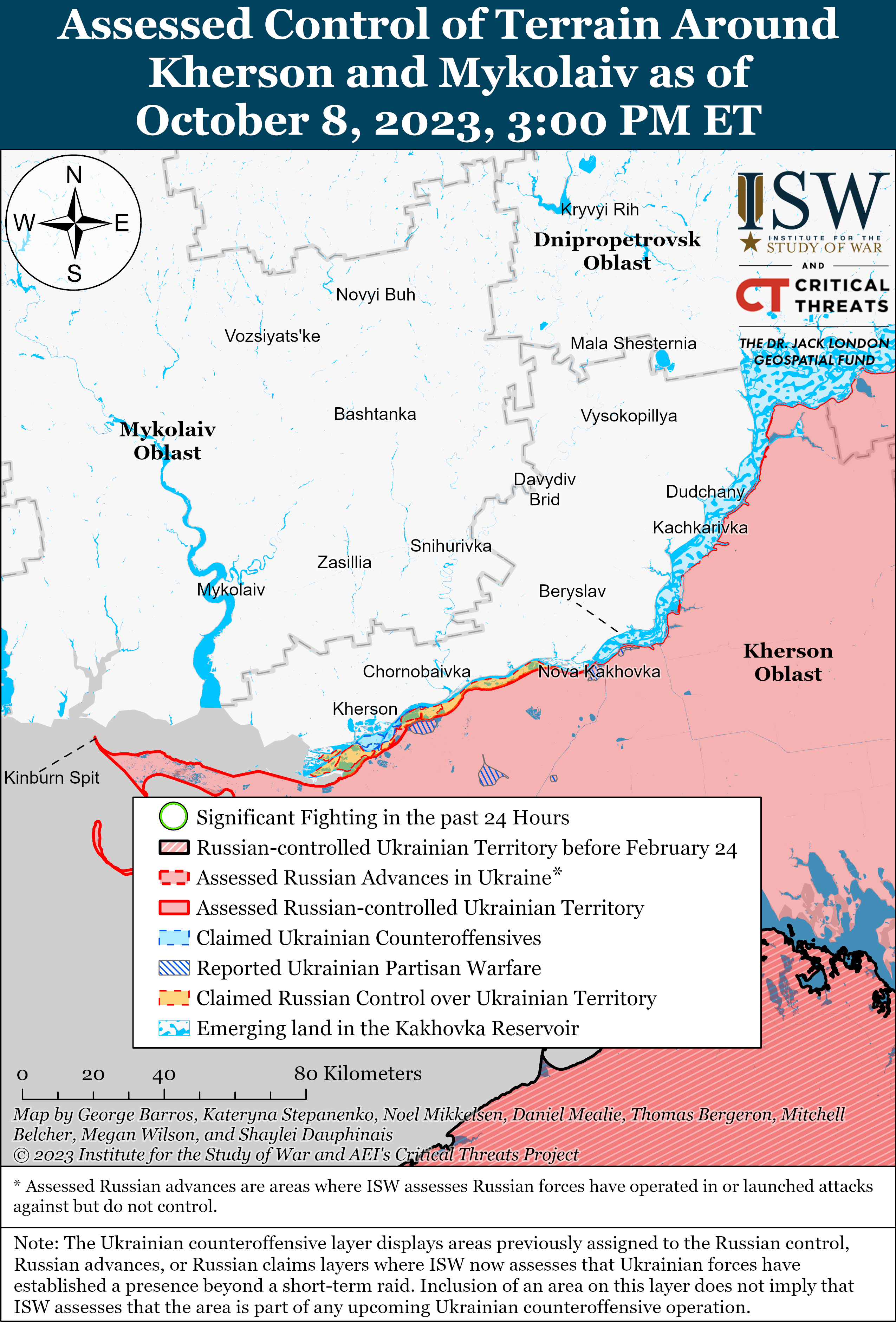
No comments:
Post a Comment